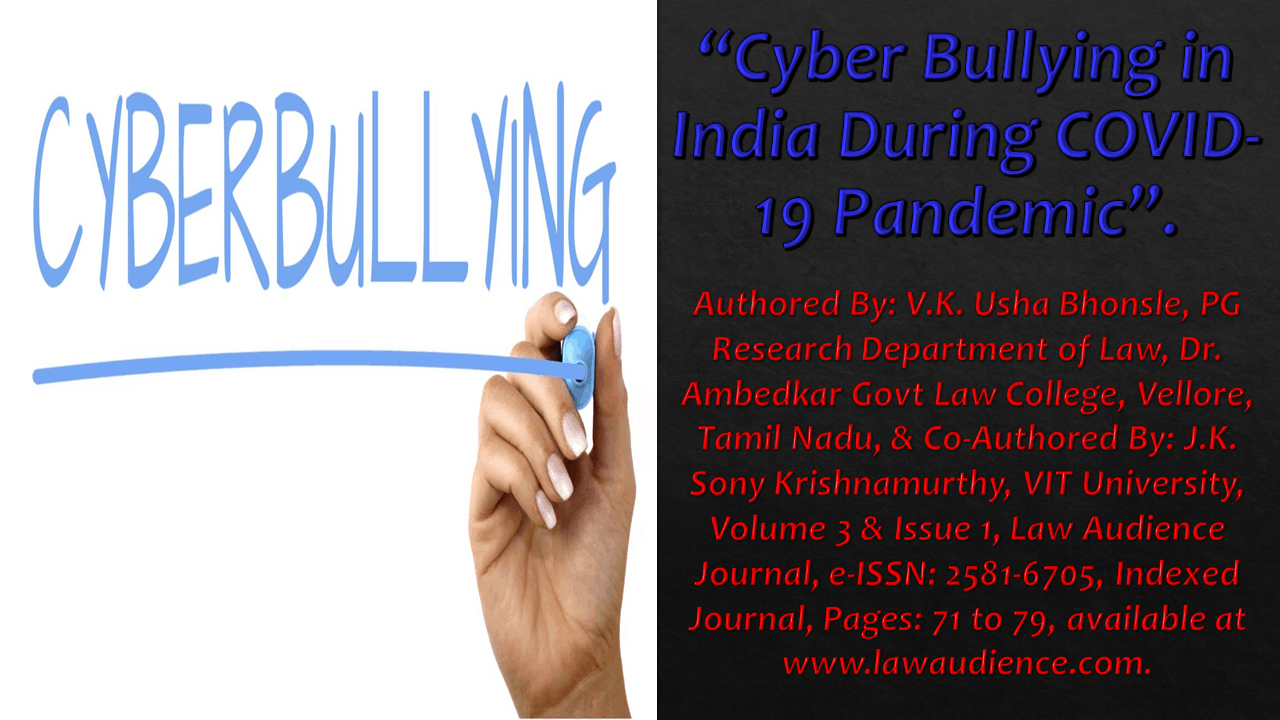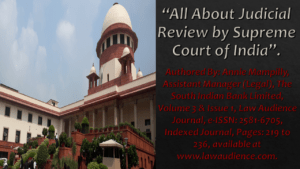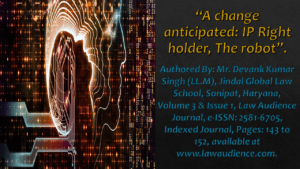Click here to download the full paper (PDF)
Authored By: V.K. Usha Bhonsle, PG Research Department of Law, Dr. Ambedkar Govt Law College, Vellore, Tamil Nadu & Co-Authored By: J.K. Sony Krishnamurthy, VIT University,
Click here for Copyright Policy.
ABSTRACT:
“The COVID-19 outbreak has made everyone enter into the digital world. It has not only affected global health but also impacted the social life. The high usage of online platforms and social media has significantly raised the number of cybercrime cases during the pandemic. India is not an exception to this international issue. Cyber bullying is one of the highly increased crime in India during this pandemic. This article glances at the problem of cyber bullying during the COVID-19 crisis focusing and explore the possibility of an increase in cyber bullying incidents due to the pandemic and high social media usage and. This article also addresses the various ways by which cyber bullying can be prevented and role of government in taking immediate steps to tackle this violence and provide relief to the victims”.
Keywords: Social media, Cyber bullying, COVID-19, Pandemic, India, Online, Children, Victim.
I. INTRODUCTION:
Cyber bullying is a form of aggressive, intentional behaviour that is carried out by a group or individual using electronic forms of contact. It can be initiated by sending or receiving text messages, video clips, or email.[1] Cyber bullying can have long-term and short-term effects. For some, it can lead to depression, self-esteem decline, and even suicide. Such online harassment can also negatively impact the mental health, with 32% of victims reporting symptoms of stress and 38% of victims experiencing emotional distress, even after the online abuse stopped. Thus, it is critical to detail cyber bullying and understands the victims’ perspectives.[2] For the perpetrators, it can also affect their social skills. During the current pandemic, individuals have increased their use of social media to remain connected to others while distancing themselves from social media. This type of internet-based life could make a concerning spike in cyber bullying. The rise of cyber bullying is inevitable due to pandemic. It is therefore important to analyze the various factors that leads to cyber bullying before making any assumptions or hypothesis.
II. WHAT IS CONSIDERED AS CYBERBULLYING?
There are many forms of cyber-bullying. The degree and nature of these cyber offences are also varied. Cyber bullies tend to resort to repeated behaviour with intent to humiliate, scare, anger, or shame the targeted victims by,
- Spreading lies about or posting embarrassing photos of someone on social media;
- Impersonating someone and sending mean messages to others on their behalf;
- Hacking personal accounts again and again;
- Flaming, which is the use of vulgar or insensitive language to attack someone;
- Sending threatening, hurtful or inappropriate messages to harass someone;
- Sharing someone’s private messages or picture or threatening/blackmailing to do so;
- Threatening someone to commit an act of violence or threats of pornography;
- Stalking someone and sending targeted messages;
- Child pornography or threats of child pornography, etc.
III. IMPACTS OF CYBERBULLYING:
The effects of cyber bullying target especially on teenagers. Sometimes, such abuse can impact both the cyber aggressors and cyber victims. It is found that both victims and perpetrators of cyber bullying were more likely to develop depression and suicidal thoughts than those involved in other types of bullying[3]. The detrimental effects of cyber bullying target on social and emotional lives. In addition to the mental impact, cyber bullying leads to behavioural changes, with victims displaying more cautious browsing habits and avoidance strategies.
IV. SOCIAL MEDIA BULLYING:
Cyber bullying can occur across a range of different online platforms, including social networks, chat rooms, and mobile messaging applications, regardless of geographic proximity. Such bullying can last as little as a week or go on for much longer. Because social networking platforms are often used as a means of self-comparison, they are a prime source of self-esteem issues.
Several high-profile incidents of cyber bullying have taken place over major social media platforms. As a mitigating measure, some prior work has focused on improving social media policies to prevent perpetrators from abusing their victims.
V. SUPPORTIVE LAWS AGAINST CYBER BULLYING:
There are no specific laws in India regarding cyber bullying. After the amendment of Indian Penal Code, 1860 in 2013[4] there are some laws to rely on such as,
- Section 499 of IPC defines defamation
- Section 292A defines printing matter intended to blackmail
- Section 354A describes sexual harassment
- Section 354D defines stalking
- Section 509 defines any word or act intended to insult a woman.
The Information Technology Amendment Act also provides remedies for cyber bullying.[5]
- Section 66A of IT Act defines punishment for a person for sending an offensive message through any communicating device
- Section 66E defines punishments for invading privacy
- Section 67 defines punishment for publishing any obscene picture.
VI. RISE OF CYBER BULLYING CASES:
Presently in India there is a huge increase in cyber bullying cases. But the number of cases reported is not proportionate to actual number of cases because 9.2% of the kids didn’t tell their teachers and parents about getting bullied.
According to Child Rights and You (CRY) 1 in 3 adults get bullied every day and most of them are aged between 13-18 years. According to the National Crime Records Bureau there is a 36% increase in cyber stalking and cyber bullying cases in India.[6]
Rittika Sharma, who was a student in a reputed Delhi school was stalked by a Facebook friend whom she unfriended months ago and whom she gave all her information including residential address, school address and even cell phone number. She told her brother regarding this and her brother filed a complaint against this. After this incident Delhi police organised an awareness programs where all the students were told not to send their personal details to any stranger.[7]
While discussing cyber stalking and Cyber bullying, Ritu Kohli’s case is the case one should mention. Ritu Kohli’s Case was the first cyber stalking case reported in India. A girl named Ritu Kohli filed a complaint in 2001 that someone else is using her identity in social media and she was deliberately getting calls from different numbers she was also getting calls from abroad. A case was also filed under Section 509 of Indian penal code.[8]
VI.I CASE LAWS ADDRESSING CYBER BULLYING:
In the case of Sazzadur Rahman vs. The State of Assam and Ors.[9], the accused created a fake Facebook profile of a 15-year-old victim. In the fake profile, the accused mentioned the victim’s name, uploaded obscene pictures, and posted some derogatory remarks against her, which caused her to be mentally unstable and hampered her academic growth. The trial court rejected the application made by the accused under Section 311 of CrPC. Thereafter, a petition under section 482 read with sections 401/397 of CrPC was filed before the Gauhati High court for quashing the order of the trial court. The Gauhati High Court, while dismissing the application, held that discretion of the trial Court, which, ex facie, has been exercised judiciously on the basis of relevant materials, cannot be interfered with either in revisional jurisdiction or under Section 482 CrPC.
In the case of Shubham Bansal vs. The State (Govt of NCT Delhi)[10], the accused created a false Facebook account in the name of Nidhi Taneja and included the telephone number of the victim, which caused her annoyance, insult, and harassment and, therefore an FIR was registered against the accused. The victim further moved another application under Section 173 (8) of CrPC requesting further investigation by the investigating officer on account of which the matter was remanded to the Metropolitan Magistrate for consideration. Thereafter, an application was made by the accused for dropping the proceedings against him under Section 66A of the IT Act and Section 509 of IPC. The Delhi High court while refusing to entertain the application of the accused, ordered that the investigating officer refrain from submitting his final report till the Magistrate issued directions on the pending application filed by the victim. The honorable court noted that the alternative course available to the investigating officer was to file a report based on the investigation carried out until then, reserving the right to file a supplementary challan/report in response to the pending application made by the victim under Section 173 (8) of CrPC seeking further investigation.
In the case of Jitender Singh Grewal vs. The State of West Bengal[11], the accused created a fake Facebook account of the victim and uploaded her obscene pictures to such fake Facebook account. After the authorities charge sheeted the accused under Sections 354A/354D/500/509/507 of IPC and Section 67A of the IT Act, he filed a bail application. The trial court rejected the bail application of the accused and the Calcutta High court upheld the trial court’s decision.
In the case of Prakhar Sharma vs. The State of Madhya Pradesh[12], the accused created a fake Facebook account of the victim, posted some vulgar messages along with the photos of the victim downloaded from her original Facebook account. The accused was charged under Sections 66 (c), 67 and 67(a) of the IT Act. When the accused applied for bail, it was denied by the Madhya Pradesh High Court.
In the case of Hareesh vs. State of Kerala[13], the applicant created a fake Facebook profile, posted morphed obscene photographs of the victim online, posted her mobile number under the said obscene post in order to enable strangers to contact her. Thereafter, an anticipatory bail application was made by the applicant apprehending arrest in respect of offences punishable under Section 354(D) of IPC and Sections 67 and 67E of the IT Act. The Kerala High court denied the application for anticipatory bail on the ground that materials on record affirmed the involvement of the applicant in the offences and it would not be proper for the court to interfere with the investigation.
VII. DEFENCE AGAINST CYBERBULLYING:
Anyone can become a victim of online harassment and bullying. Sometimes, the person may not even be aware that he/she is a victim of cyber bully or harassment. As mentioned before, this tends to have a deep psychological impact on the target. In extreme cases, cyber bullying can drive the victim to take drastic steps like self-harm and even suicide. Victims need to speak up and speak out or talk to a family member or a reliable, trusted person. Victims of cyber bullying can file a complaint against the ‘bully’ and initiate legal actions against such miscreants.
VIII. CONSEQUENCES OF CYBER BULLYING FACED BY CHILDREN:
The consequences of cyber bullying can be severe. Amongst other victims i.e., all the people on the social media of all ages, children are the ultimate victims of this crime as they are the ones who are using the internet to its maximum ability. Therefore, such children should be safeguarded from the negative side of the same. These disrespectful, demeaning and hatred or threatening words/audio/video that are posted on such online platforms affects the mental stability, mental peace and mental health of the children.
Such children as we can call them victims of cyber bullying react in different ways to this crime when it happens to them. Some of them committed suicide in the fear of facing the world, some changed their schools and colleges with the similar fear of losing their self-esteem or reputation or there are families who move their residence from one locality to the other or from one city to the other to protect their reputation.
There are families who tell their children to not share this news of them being bullied on the online platform or any social media to anyone in public or they don’t even allow their children to report such cases as then the case will come in notice of the public.
IX. CONCLUSION:
Cyber bullying is a very prevalent issue in today’s world. There have been several speculations regarding the increase in this rise of cyber bullying incidents during COVID-19. If no steps are taken against cyber bullying, this can create a huge problem on the Internet.
Lawmakers should discuss with the psychiatrists to make law against cyber bullying because bullying causes a huge mental pressure among children and mostly children are the victims. Not only cyber bullying, there are many other cybercrimes happening all over the country which needs separate laws.
If laws are not made soon the victims will have to suffer more. But as we all know, precautions are better than cure, the students need to be more aware and need to use Internet positively, they need to take security measures on their social media profiles.
Footnotes:
[1] Michele L. Ybarra and Kimberly J. Mitchell, Online Aggressor/Targets, Aggressors, And Targets: A Comparison of Associated Youth Characteristics, Journal of Child Psychology and Psychiatry 45:7 (2004), pp 1308–1316, available at http://unh.edu/ccrc/pdf/jvq/CV75.pdf.
[2] Michele L Ybarra, Kimberly J Mitchell, Janis Wolak, David Finkelhor, Examining Characteristics and Associated Distress Related to Internet Harassment: Findings from The Second Youth Internet Safety Survey, Pediatrics October 2006, 118 (4) e1169-e1177, available at https://pediatrics.aappublications.org/content/118/4/e1169.
[3] Hinduja S, Patchin JW, Bullying, Cyberbullying, and Suicide, Arch Suicide Res. 2010; 14(3):206-21.
[4] The Criminal Law (Amendment) Act, No.13 of 2013, available at https://www.iitk.ac.in/wc/data/TheCriminalLaw.pdf.
[5] The Information Technology (Amendment), Act, 2008, No.10 of 2009, available at https://eprocure.gov.in/cppp/rulesandprocs/kbadqkdlcswfjdelrquehwuxcfmijmuixngudufgbuubgubfugbububjxcgfvsbdihbgfGhdfgFHytyhRtMTk4NzY=.
[6] Rhea Maheshwari, In One Year Alone, Cyberbullying of Indian Women and Teenagers Rose By 36%, available at https://scroll.in/article/956085/in-one-year-alone-cyberbullying-of-indian-women-and-teenagers-rose-by-36.
[7] Adrita, Cyber Bullying: A Disregarded Issue in India, available at http://www.legalserviceindia.com/legal/article-2358-cyber-bullying-a-disregarded-issue-in-india.html.
[8] Ibid.
[9] Sazzadur Rahman v. The State of Assam and Ors., Criminal Petition No. 654 of 2019.
[10] Shubham Bansal v. The State (Govt of Nct Delhi), Criminal Miscellaneous Petition No. 2024 of 2018.
[11] Jitender Singh Grewal v. The State of West Bengal, Criminal Miscellaneous Petition No. 7252 of 2018.
[12] Prakhar Sharma v. The State of Madhya Pradesh, MCRC No. 377 of 2018.
[13] Hareesh v. State of Kerala, Bail Application No. 4858 of 2018.
References:
- MICHELE L. YBARRA AND KIMBERLY J. MITCHELL, Online Aggressor/Targets, Aggressors, And Targets: A Comparison of Associated Youth Characteristics, Journal of Child Psychology and Psychiatry 45:7 (2004), pp 1308–1316, available at http://unh.edu/ccrc/pdf/jvq/CV75.pdf.
- MICHELE L YBARRA, KIMBERLY J MITCHELL, JANIS WOLAK, DAVID FINKELHOR, Examining Characteristics and Associated Distress Related to Internet Harassment: Findings from The Second Youth Internet Safety Survey, Pediatrics October 2006, 118 (4) e1169-e1177, available at https://pediatrics.aappublications.org/content/118/4/e1169.
- HINDUJA S, PATCHIN JW, Bullying, Cyberbullying, and Suicide, Arch Suicide Res. 2010; 14(3):206-21.
- The Criminal Law (Amendment) Act, No.13 of 2013, available at https://www.iitk.ac.in/wc/data/TheCriminalLaw.pdf.
- The Information Technology (Amendment), Act, 2008, No.10 of 2009, available at https://eprocure.gov.in/cppp/rulesandprocs/kbadqkdlcswfjdelrquehwuxcfmijmuixngudufgbuubgubfugbububjxcgfvsbdihbgfGhdfgFHytyhRtMTk4NzY=.
- RHEA MAHESHWARI, In One Year Alone, Cyberbullying of Indian Women and Teenagers Rose By 36%, available at https://scroll.in/article/956085/in-one-year-alone-cyberbullying-of-indian-women-and-teenagers-rose-by-36.
- ADRITA, Cyber Bullying: A Disregarded Issue in India, available at http://www.legalserviceindia.com/legal/article-2358-cyber-bullying-a-disregarded-issue-in-india.html.
- Sazzadur Rahman v. The State of Assam and Ors., Criminal Petition No. 654 of 2019.
- Shubham Bansal v. The State (Govt of Nct Delhi), Criminal Miscellaneous Petition No. 2024 of 2018.
- Jitender Singh Grewal v. The State of West Bengal, Criminal Miscellaneous Petition No. 7252 of 2018.
- Prakhar Sharma v. The State of Madhya Pradesh, MCRC No. 377 of 2018.
- Hareesh v. State of Kerala, Bail Application No. 4858 of 2018.
Cite this article as:
V.K. Usha Bhonsle & J.K. Sony Krishnamurthy, Cyber Bullying in India During COVID-19 Pandemic, Vol.3 & Issue 1, Law Audience Journal, Pages 71 to 79 (31st May 2021), available at https://www.lawaudience.com/cyber-bullying-in-india-during-covid-19-pandemic.



